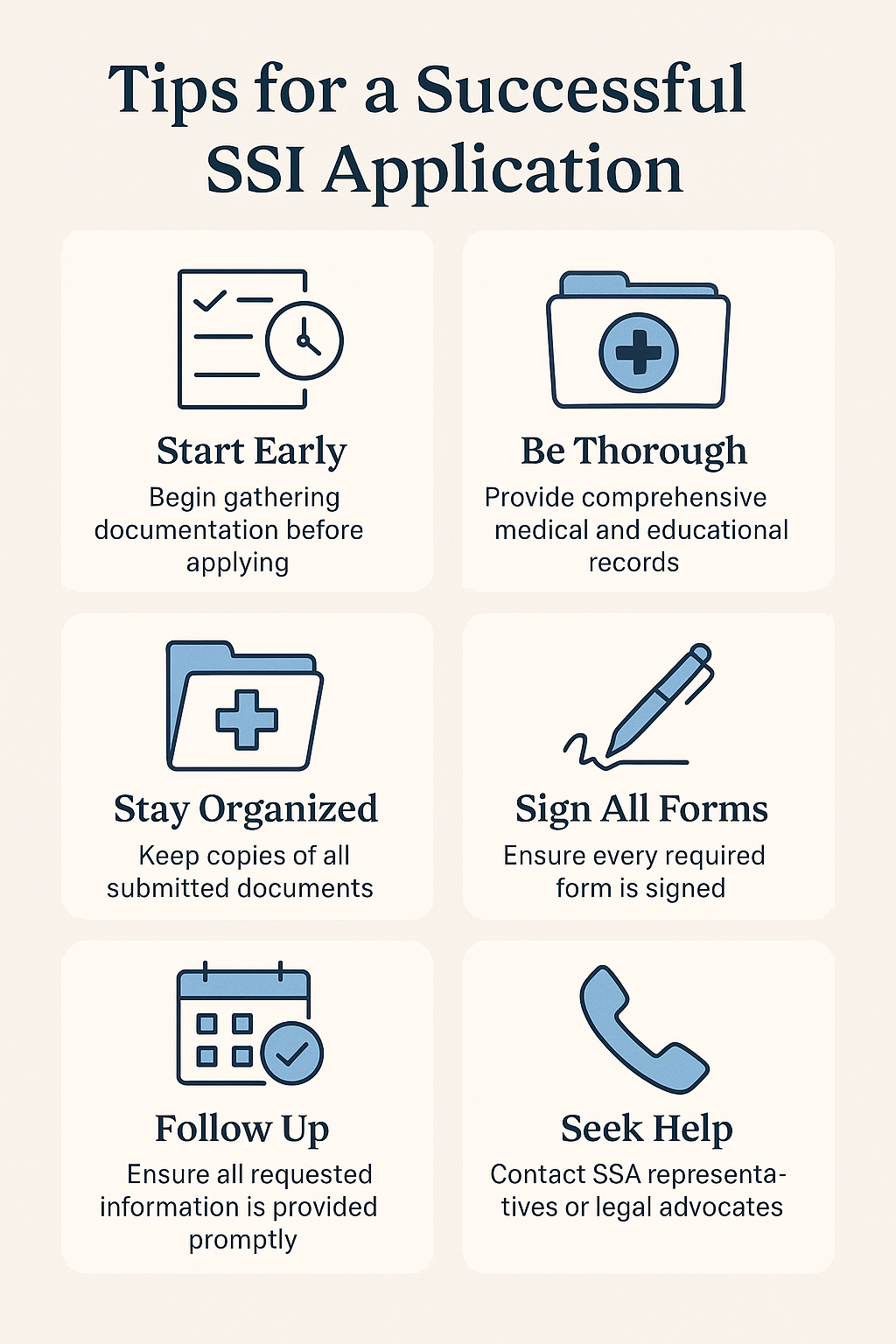Before beginning the SSI application for children, families must understand both the medical and financial criteria that determine eligibility. Supplemental Security Income (SSI) is a federal program that provides financial assistance to both children and adults with disabilities.
SSI is designed for individuals with limited income and resources. SSI pays benefits to help cover basic needs such as food, shelter, and medical care. Children who qualify for SSI benefits are also eligible for Medicaid health insurance, which provides medical and dental care not covered by other insurance. The program is funded by federal taxes.

SSI is available for people who are blind, as well as those with other disabilities. The Social Security Administration (SSA) uses strict guidelines to evaluate each case individually. Supplemental Security Income is based on financial need, while Social Security Disability Insurance (SSDI) is a separate program based on work history.
Medical Eligibility: What Conditions Qualify?
For a child to qualify medically for SSI, they must have a physical or mental condition that:
- Very seriously limits their activities
- Has lasted, or is expected to last, for at least one year or result in death
The Disability Determination Services (DDS), a state agency, evaluates all medical evidence, including the child’s medical records and documentation of the child’s disability status, to determine if a child meets these criteria. Common qualifying conditions include:
Neurological Disorders:
- Cerebral palsy
- Epilepsy
- Traumatic brain injuries with lasting effects
- Autism spectrum disorder (depending on severity)
- Severe intellectual disabilities
- ADHD with significant functional limitations
- Severe anxiety, depression, or bipolar disorder
Developmental Disorders:
- Down Syndrome
- Learning disorders with significant impact
- Speech and language impairments
- Genetic disorders causing developmental delays
Chronic Illnesses:
- Severe asthma requiring frequent hospitalizations
- Cystic fibrosis
- Congenital heart disease
- Symptomatic HIV infection
Special Considerations for Infants: Low birth weight and failure to thrive can qualify infants under one year for immediate SSI payments, providing crucial early support for vulnerable newborns.
Financial Eligibility: Understanding Parental Deeming
The SSI application for children involves a complex financial evaluation called “parental deeming.” This process is based on a portion of parents’ income and resources being considered as available to the child, which can significantly impact eligibility. The family’s income is considered when determining a child’s eligibility for SSI.
Income Calculations: The SSA evaluates both earned income (wages, self-employment) and unearned income (Social Security benefits, unemployment, child support). However, not all income counts toward the limit:
Excluded Income:
- Food Stamps (SNAP benefits)
- Welfare (TANF) payments
- SSI benefits received by parents
- VA pension payments
- The first $20 of any unearned income
- The first $65 of earned income plus half of remaining earned income
Family Allocations: The SSA reduces countable parental income by providing allowances for:
- Each non-disabled child in the household ($483 per child in 2025)
- Parents themselves ($967 for single parent, $1,450 for married couple in 2025)
Resource Limits: Countable resources (assets that can be converted to cash) are limited to $2,000 for the child. Parents can exclude $2,000 (single parent) or $3,000 (married couple) of their resources from this calculation. The child’s living situation and savings are also reviewed as part of the eligibility process. Excess savings above the allowed limit may affect eligibility.
When Deeming Stops: Parental deeming ends when a child turns 18, marries, no longer lives with parents, or when a parent becomes eligible for SSI.
SSI Benefits Application Process
Successfully completing the Supplemental Security Income application requires careful preparation and attention to detail. Families can apply online for SSI benefits through the Social Security website, which offers a convenient way to start the process. Applicants will need to fill out several forms, so having all necessary documents and information ready can help avoid delays. The application process requires detailed documentation of the child’s disability, including medical records and proof of eligibility as a minor.
Complete the Child Disability Report
Begin by completing the Child Disability Report (SSA-3820-BK) online. This comprehensive form takes approximately one hour and gathers detailed information about:
- The child’s disabling condition, including a detailed history of the child’s condition
- How the disability affects daily functioning
- Medical treatment history, including a list of all the child’s healthcare providers and medications
- Educational services received
For example, when describing medical treatment history, include the names and contact information of all doctors, dates of visits, and any prescribed medications.
Pro Tip: Use the Child Disability Starter Kit available online, which includes helpful checklists and worksheets to ensure you provide complete information.
Schedule Your Interview with Social Security Administration
After submitting the Child Disability Report, a Social Security representative will contact you within 3-5 business days to:
- Review your completed report
- Discuss your household’s financial situation
- Begin the formal SSI application process
- Help you schedule an appointment for the formal SSI application interview, during which you will complete Form SSA-8000 (Application for SSI)
Gather Required Documentation
Thorough documentation can significantly impact the success of your SSI application. Be sure to bring all necessary papers, including a copy of the child’s birth certificate showing where and when they were born.
The Social Security Administration will make a copy of your original documents during the interview and return the originals to you afterward.
Medical Documentation:
- Complete contact information for all healthcare providers
- Medical records from the past year or longer
- Current medication lists with dosages
- Detailed letters from treating physicians explaining how the condition impacts the child’s functioning
- Lab results, imaging studies, and test results
Educational Records:
- School contact information for the past 12 months
- Individualized Education Programs (IEPs)
- 504 plans
- Teacher reports and disciplinary records
- Standardized test scores
- Early intervention service plans (IFSPs)
Financial Information:
- Pay stubs and income documentation for all household members
- Bank statements and asset information
- Rent receipts or mortgage information
- Proof of any other benefits received
- Documentation of any funds received or held for the child, including how SSI funds are used or saved
Attend Consultative Examinations
If the DDS determines that additional medical evidence is needed, they may schedule a Consultative Examination (CE) at no cost to your family. These independent medical examinations are crucial to the decision-making process, so attendance is vital for a successful application.
What to Expect During the Evaluation Process

The Supplemental Security Income application typically takes 3-5 months for an initial decision, as the evaluation process often spans several months. The SSA uses a detailed review process to decide whether a child qualifies for SSI, which includes an interview, documentation review, and sometimes follow-up assessments.
If approved, SSI payments usually begin the month after approval. Approved applicants receive a monthly payment, and these monthly payments provide money to help cover living expenses. During this time, the DDS reviews all submitted information and may request additional documentation or examinations. The state agency carefully evaluates how the child’s condition compares to other children of the same age without disabilities.
Understanding the evaluation timeline helps families plan accordingly and reduces anxiety about the waiting period. The SSA believes all relevant information must be considered before making a decision. Families should check the status of their application regularly and ensure all required steps are completed to avoid delays in payment. The SSA will send written notification of their decision, whether approval or denial.
Navigating the Appeals Process
Unfortunately, many initial SSI applications are denied. Families will receive an official letter from the SSA notifying them of the decision and outlining next steps if denied. If you have questions about the appeals process, SSA representatives or legal advocates can help answer them and provide guidance. Families have the right to appeal these decisions through a four-level process:
Request for Reconsideration
File within 60 days of the denial notice. A different examiner reviews the entire case, including any new evidence you provide.
Administrative Law Judge Hearing
If reconsideration is denied, request a hearing within 60 days. This allows you to present your case directly to a judge, offer new evidence, and have legal representation.
Appeals Council Review
Request review within 60 days of an unfavorable ALJ decision. The Appeals Council examines the case for legal or procedural errors.
Federal Court Review
File a civil action in U.S. District Court within 60 days if previous appeals are unsuccessful.
Important: Consider seeking assistance from an experienced disability attorney, especially during appeals. Legal representation can significantly improve your chances of success.
Continuing Disability Reviews: Maintaining Benefits
Once approved, children receiving SSI undergo periodic Continuing Disability Reviews (CDRs) to ensure ongoing eligibility:
- Expected improvement conditions: Reviewed every 3 years
- Low birth weight cases: Reviewed by age one
- Unlikely improvement conditions: Reviewed every 5-7 years
- Age-18 redetermination: Mandatory review using adult disability standards; when a child turns 18, they are evaluated as an adult child under these adult disability criteria
During CDRs, families must provide updated medical information and demonstrate ongoing treatment compliance. The person’s condition is re-evaluated to determine if the person receiving SSI still meets disability criteria.
Special Considerations and Additional Resources
Section 301 Safety Net
If a child is found no longer disabled during a CDR, SSI payments may continue if they’re participating in approved educational or vocational rehabilitation programs that began before the cessation decision.
Available Support Services
Families navigating the SSI application can access:
- Free interpreter services
- Child Disability Starter Kit resources
- Legal assistance through disability advocacy organizations
- Support from local Social Security offices, and can also create an online account to manage their application and benefits.
You can apply for SSI by phone, or use TTY services if you are deaf or hard of hearing.
Tips for Success

- Start early: Begin gathering documentation before applying
- Be thorough: Provide comprehensive medical and educational records
- Stay organized: Keep copies of all submitted documents
- Sign all forms: Make sure to sign every required form and check that your signature is present on all official documents submitted to the SSA.
- Follow up: Ensure all requested information is provided promptly
- Seek help: Don’t hesitate to contact SSA representatives or legal advocates
Find The Right Support For Your Child
Remember that Supplemental Security Income (SSI) provides more than just financial support—it often opens doors to Medicaid coverage and other services that can dramatically improve a disabled child’s quality of life and future prospects.
If you believe your child may qualify, don’t let the complexity of the system discourage you from applying. With proper preparation and understanding of the process, families can successfully navigate the SSI application and secure the support their child deserves.
For families just beginning this journey, take advantage of available resources, consider professional guidance when needed, and remember that advocacy for your child’s needs is both your right and responsibility. The SSI program exists to provide crucial support during challenging times, and with persistence, you can help ensure your child receives the benefits that can make a meaningful difference in their life.
At Benefits.com, we are here to help you navigate the process and receive the benefits you deserve. Begin today by taking our free eligibility quiz.
 Benefits.com Advisors
Benefits.com Advisors
With expertise spanning local, state, and federal benefit programs, our team is dedicated to guiding individuals towards the perfect program tailored to their unique circumstances.
Rise to the top with Peak Benefits!
Join our Peak Benefits Newsletter for the latest news, resources, and offers on all things government benefits.



















